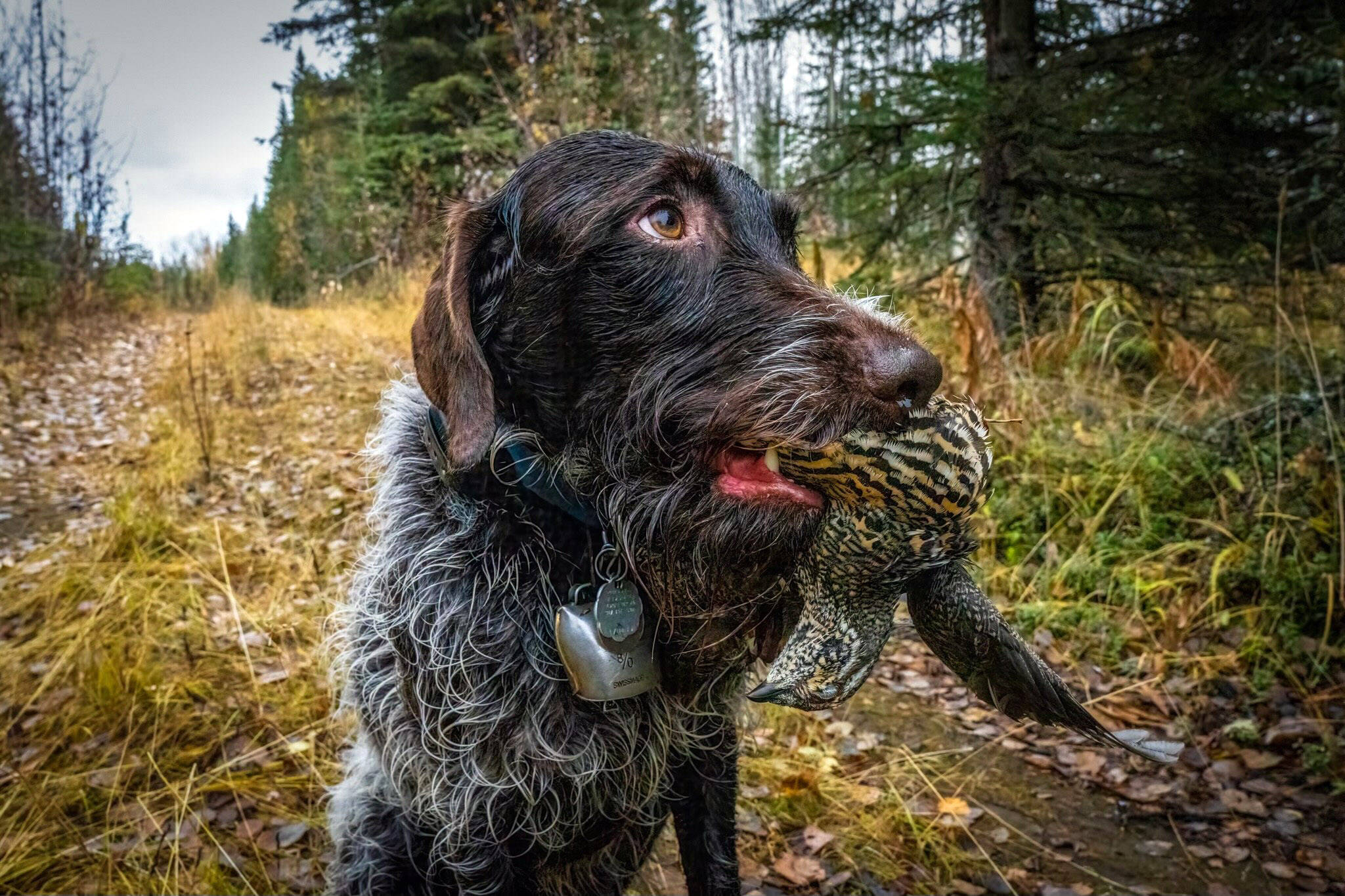His eyes were fixated on the white spruce before us. We knew what we sought was in there based on his behavior, but no matter how hard we scanned the foliage, it could not be seen.
I felt the breeze on my face start to pick up and saw his nose rise as he searched for that familiar scent. Slowly he moved forward, placing each step with extreme precision.
Suddenly, as if he had just peered into the eyes of Medusa, he froze. His tail was erect, one front paw was cocked upright at a 45-degree angle, and the other three were firmly planted on the ground. A slight but noticeable quiver began to pulse in one of his hind legs, sending a ripple throughout his body.
Just when I thought his excitement could not be contained any longer, Sam gave the word. The dog sprang into action and out flushed the spruce grouse. It sailed between the trees like an F-18, twisting and turning around each bough.
Sam pulled up his shotgun and downed the bird just before it was out of sight. Immediately his dog was on it and came trotting back to us with the grouse in his mouth, gently placing it in Sam’s hand.
A few days before, Sam, a buddy of mine from work, asked if I wanted to tag along with him and his dog named Deiter, in search of grouse and hares.
Deiter is his 3-year-old Wirehaired Pointing Griffon, a sporting dog breed with which I was unfamiliar. I had hunted with quite a few other breeds but never a “griff.” I was excited to get out and see how the dog would perform.
I met up with Sam at a refuge trailhead to start our quest searching for feathers and fur. As I pulled up, Sam let Deiter out to greet me. With my lack of knowledge of the different sporting dog breeds, I would have thought, at first sight, he was German Wirehaired Pointer.
Instead, he was a well-built, medium-sized dog with a rough, wiry coat and well-defined beard. He had an almost rustic-looking appearance. For a moment, my thoughts turned to a painting I once saw on the cover of an old Field and Stream magazine.
As we started walking, Deiter’s friendly and playful disposition switched to all business. Right off the bat, he picked up a scent and started working the alders, searching for what had left it behind. Sam told the dog to ease up as we closed in.
As I admired Deiter, completely locked on and pointing, I saw movement out of the corner of my eye. A snowshoe hare was making its departure, scampering through the thick rosehips and devil’s club.
Sam gave the command, and Deiter released from his statuelike state to pursue the hare, his nose to the ground. This hare was no fool and would not provide us another glimpse. On down the trail, we continued.
Throughout the morning, we chatted on a mixed sample of topics, but mostly how fortunate we were to live in a state with such bountiful small game and bird hunting opportunities. Depending on the region, Alaska allowed for a chance to pursue the different grouse species such as sharptail, spruce, ruffed and sooty.
On the Kenai, we’re fortunate to have all three species of ptarmigan: rock, willow and white-tailed. Then there is the lengthy list of waterfowl species (ducks and geese). Alaska Department of Fish and Game provides fantastic resources to help you find whatever species you decide to pursue and where the best opportunities to find them would be.
When I asked Sam why he chose this particular dog breed, he explained that it was a multitude of factors based on temperament, hunting ability and lifestyle. He wanted a dog to take hunting for the day or just sit back with and chill on the couch. There are a lot of fantastic hunting breeds out there, but the “Griff” just seemed to fit all of his criteria.
It didn’t matter whether you were searching for snowshoe hares, retrieving ducks from a blind, pointing grouse/ptarmigan, or on the blood trail tracking a downed animal. They are a do-it-all kind of dog. This versatility and ability to handle the colder climates make them an outstanding choice for this state.
We got back to the truck with a total of two grouse, though we saw many more. We cleaned the birds and took them home to prepare for the table. There is a seemingly endless number of ways to prepare what’s been harvested, and everyone seems to have their personal favorite.
So, Sam and I each whipped together our own take on the “best” way to eat grouse and sat down for a delightful meal! We compared each other’s concoctions and gave lighthearted jabs at what the other could have done better.
With full bellies, we sat back and reminisced about the trip. We conversed on how great the day was and how beautiful the fall colors were, the grouse we saw and the opportunities missed. But the greatest takeaway was not so much the pursuit of the quarry that made this an enthralling experience. It was watching the relationship between Sam and his best friend, Deiter.
Colin Canterbury is a biological technician on the Kenai National Wildlife Refuge. Find more Refuge Notebook articles (1999–present) at https://www.fws.gov/refuge/Kenai/community/refuge_notebook.html.

